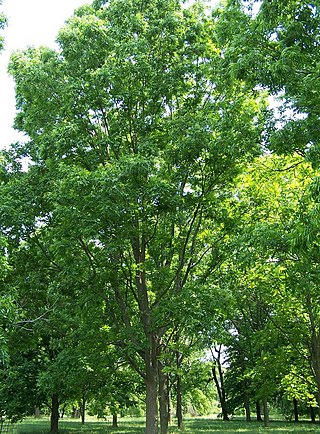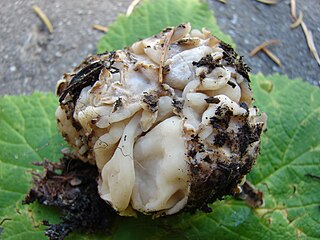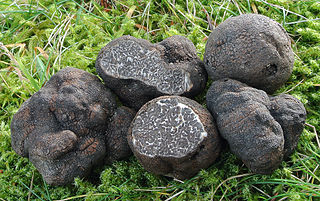
Edible mushrooms are the fleshy fruit bodies of several species of macrofungi. Edibility may be defined by criteria including the absence of poisonous effects on humans and desirable taste and aroma. Edible mushrooms are consumed for their nutritional and culinary value. Mushrooms, especially dried shiitake, are sources of umami flavor.

The pecan is a species of hickory native to the southern United States and northern Mexico in the region of the Mississippi River.

A truffle is the fruiting body of a subterranean ascomycete fungus, predominantly one of the many species of the genus Tuber. In addition to Tuber, over one hundred other genera of fungi are classified as truffles including Geopora, Peziza, Choiromyces, and Leucangium. These genera belong to the class Pezizomycetes and the Pezizales order. Several truffle-like basidiomycetes are excluded from Pezizales, including Rhizopogon and Glomus. Truffles are ectomycorrhizal fungi, so they are usually found in close association with tree roots. Spore dispersal is accomplished through fungivores, animals that eat fungi. These fungi have significant ecological roles in nutrient cycling and drought tolerance.

Betula nigra, the black birch, river birch or water birch, is a species of birch native to the Eastern United States from New Hampshire west to southern Minnesota, and south to northern Florida and west to Texas. It is one of the few heat-tolerant birches in a family of mostly cold-weather trees which do not thrive in USDA Zone 6 and up. B. nigra commonly occurs in floodplains and swamps.

Geopora cooperi, commonly known as the pine truffle or the fuzzy truffle, is a species of fungus in the family Pyronemataceae. It has a fuzzy brown outer surface and an inner surface of whitish, convoluted folds of tissue. Widely distributed in the Northern Hemisphere, the species has been recorded from Asia, Europe, and North America.

Tuber oregonense, commonly known as the Oregon white truffle, is a species of edible truffle in the genus Tuber. Described as new to science in 2010, the North American species is found on the western coast of the United States, from northern California to southern British Columbia west of the Cascade Range. A mycorrhizal fungus, it grows in a symbiotic association with Douglas fir. It overlaps in distribution with the closely related T. gibbosum, but they have different growing seasons: T. oregonense typically appears from October through March, while T. gibbosum grows from January to June. The fruit bodies of the fungus are roughly spherical to irregular in shape, and resemble small potatoes up to 5 cm (2 in) in diameter. Inside the truffle is the gleba, which is initially white before it becomes a marbled tan color. The large, often thick-walled, and strongly ornamented spores are produced in large spherical asci. The truffle is highly prized for its taste and aroma. Some individuals have claimed success in cultivating the truffles in Christmas tree farms.

Tuber is a genus in the fungal family Tuberaceae, with estimated molecular dating to the end of the Jurassic period. It includes several species of truffles that are highly valued as delicacies.

Kalapuya brunnea is a species of truffle in the monotypic fungal genus Kalapuya. The truffle occurs only in the Pacific Northwest region of the United States, in western Oregon and northern California. Known locally as the Oregon brown truffle, it was formerly thought to be an undescribed species of Leucangium until molecular analysis demonstrated that it was distinct from that genus. The truffle is reddish brown with a rough and warty outer skin, while the interior spore-producing gleba is initially whitish before developing greyish-brown mottling as it matures. Mature truffles have an odor resembling garlicky cheese, similar to mature Camembert. The species has been harvested for culinary purposes in Oregon.

Tuber lijiangense is a species of truffle in the family Tuberaceae. Found in China, it was described as a new species in 2011. Fresh truffles are pale yellow or light brown, roughly spherical, and measure up to 3 cm (1.2 in) in diameter.

Tuber polyspermum is a species of truffle in the family Tuberaceae. Found in China, it was described as new to science in 2011. Fruit bodies of the truffle are small and brown, measuring up to 1.5 cm (0.6 in) in diameter.

Tuber sinoalbidum is a species of truffle in the family Tuberaceae. Known only from China, it was described as a new species in 2011. Fresh truffles are whitish with a similarly colored interior, and measure up to 4.5 cm (1.8 in) in diameter.

Tuber sinoexcavatum is a species of truffle in the family Tuberaceae. Described as a new species in 2011, it is found in China. The pale yellowish-brown to brown truffles measure up to 3 cm (1.2 in) in diameter. The species is named for its close resemblance to the common European truffle T. excavatum.

Tuber melanosporum, called the black truffle,Périgord truffle or French black truffle, is a species of truffle native to Southern Europe. It is one of the most expensive edible fungi in the world. In 2013, the truffle cost between 1,000 and 2,000 euros per kilogram.

Stachys floridana is a species of betony in the mint family, Lamiaceae. It is native to the United States, where its true native range is probably limited to Florida, but today it is known throughout the Southeast as an introduced species and common weed. It occurs as far west as Texas, and it has been recorded in California. Its common names include Florida betony, Florida hedgenettle, and rattlesnake weed. It has been called wild artichoke, but it is not closely related to artichoke. The plant was the Florida Department of Agriculture's "Weed of the Month" for February 2010.

Tuber donnagotto is a species of truffle in the family Tuberaceae. Described as a new species in 2012, it is found in Croatia. The black truffle measures 2–7 cm (0.8–2.8 in) in diameter.

Pecan scab is the most economically significant disease of pecan trees in the southeastern United States. Venturia effusa is a fungal plant pathogen that causes pecan scab. The fungus causes lesions and tissue death on pecan twigs, petioles, leaves, nuts and shucks beginning in early spring, with multiple cycles of infection repeating until late summer. Wind and rain spread the fungus to a susceptible host. Control of the disease is achieved by fungicide, sanitation and, in some cases, quarantine.

Tuber macrosporum, commonly known as the smooth black truffle, is a species of edible truffle in the family Tuberaceae. Found in Europe, and common in central Italy, the truffle was described as new to science by Italian mycologist Carlo Vittadini in 1831. The truffles are roughly spherical to irregular in shape, and typically measure 0.5 to 2 centimetres in diameter. The surface color ranges from reddish brown to rust to blackish. Warts on the fruit body surface are low, so that the truffle appears fairly smooth. The truffle flesh is purplish brown to grey-brown with thin white veins. It has an intense garlic-like odor similar to the Italian white truffle. Host plants of T. macrosporum include poplars, hazel, linden, and oaks.

Leucangium carthusianum is a species of ascomycete fungus. It is commonly known as the Oregon black truffle. It is found in the Pacific Northwest region of North America, where it grows in an ectomycorrhizal association with Douglas-fir. It is commercially collected, usually assisted by a specially trained truffle dog. Mature fruiting bodies can be dug up mostly during winter, but the season can extend from September through April.

Tuber borchii, known as the whitish truffle or bianchetto truffle, is a small, common species of edible truffle excellent for use in cuisine.

Tuber indicum, commonly known as the Chinese black truffle or the Asian black truffle, is an edible fungus known for its hypogean fruiting bodies, characteristic of the Tuber genus. It is found natively in Himalayan India and parts of China, but has also been found invasively in the United States and Italy. It is sold commercially and often confused with Tuber melanosporum.


















